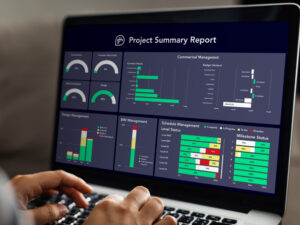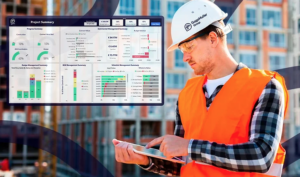
The Top 3 Benefits of 3D Laser Scanning in Construction
BLOG Have you been on site when there are issues
Poor project performance with cost and time overruns is a common problem in the construction industry. The majority of cost blowouts or delays occur due to a lack of communication on-site, inconsistencies in paperwork and a lack of coordination between stakeholders.
It is crucial to invest time at the beginning of the project to understand what you need to report on and how information should flow through the various project stakeholders.
Typically, project reports are only there to facilitate basic contractual requirements and are generated as a tick-box exercise. However, the focus should be on producing timely, accurate and transparent reports that enable decision-makers to extract actionable insights to drive project improvement opportunities.
A big issue project managers face is not having access to current and accurate information about their projects. The transition of information can get lost or warped and it is difficult to keep track of what is actually occurring in real time. Typical reports are subjective and constructed to convey a positive narrative rather than to dig into real issues and problems relating to the project.
Managing the delivery of large construction projects is a difficult task due to complex interdependencies between everyone involved in the process and complications within any of these factors can cause major setbacks. Nevertheless, the real problem dwells in how they are communicated and dealt with to mitigate the impact on the project.
People are usually reluctant to reveal issues or bad news as they don’t want to look incompetent, but this is exactly the core function of reporting: passing on the issues in a prompt and transparent fashion to ensure that appropriate action is taken to resolve them.
Typical issues with most project reporting processes are:
Poor quality of information
Delay with outdated data in reports
Administratively heavy, manual data entry
Duplication of reports
Lack of transparency with project reports
Lack of digital process
Reporting requirements not clearly defined or included as part of the contracts
You must consider what information is important to the team and how it will emanate from boots on the ground to senior management. You need lean processes in place that can integrate into existing workflows that are enabled by digitised systems to facilitate the flow of data in an automated way.
It is crucial to invest time at the beginning of the project to understand what you need to report on and how information should flow through the various project stakeholders.
Typically, project reports are only there to facilitate basic contractual requirements and are generated as a tick-box exercise. However, the focus should be on producing timely, accurate and transparent reports that enable decision-makers to extract actionable insights to drive project improvement opportunities.
The ideal situation is to have live reporting with a good flow of data that is accurate, clearly defined, and incorporated as a requirement within Contracts. This requires a project reporting plan which defines the process, people and technology requirements. The focus should be on quality and transparency to ensure a good flow of data for everyone involved in the project.
During the pre-construction stage before any major contracts have been awarded, clear plans should be developed to define information requirements. It is important that these plans are incorporated within the contracts so they can be enforced effectively.

The foundation of a robust project reporting process is a good Information Management Plan (IMP). The IMP should clearly define all aspects of the project information requirements such as:
What information is required and in what format
Who is required to provide it
When it is required and the update frequency
There must be clear standards on the type and format of the information. This can be a challenging task to specify. It is often overlooked or developed with a broad stroke that doesn’t provide adequate guidance for people on the project. There have been great improvements in this area with the development of international standards such as ISO 19650 that provide a framework for information management. However, it is also important to understand your specific project needs so they can be incorporated into the information management plan, even if not explicitly defined by the ISO standard.
Information silos between departments must be minimised and managed to ensure data can flow freely. One prime example of this is the naming and categorisation of work packages between the commercial and scheduling departments. Typically there is no standard naming convention in place, which makes it very difficult to correlate construction program information with cost report information. To achieve a good flow of information between project departments the following information types must be clearly defined and categorised:
Work Packages
Work Breakdown Structure
Location information (Project Zones, Areas, Rooms)
Asset Information (Disciplines, Categories, Types, Metadata)
Having good communication between all project stakeholders is critical to the success of any project. It is important that information is communicated in a clear efficient manner and easily accessible across the project. A project communication plan should be developed along with an information management plan to define how information flows through the project. The communication plan should identify:
Key Project Stakeholders
How important information will be communicated to stakeholders
Who is responsible for producing the information
Who will be receiving the communication,
How those people will receive it, when they’ll receive it, and how often they should expect to receive that information.
Selecting a suitable technology stake for your project can be a daunting task with the abundance of software solutions available on the market. It is important to define your information management processes and procedures first, then look to software to optimise them. The focus must be on the end user to ensure the software is user-friendly, provides adequate functionality, is customisable and ideally cloud compatible to facilitate automated data extraction via API connections.
At GagaMuller our team brings a strong project management background that is empowered by best-in-class technology expertise. This combination is invaluable when configuring and deploying software solutions. Even the best software is useless if it is not configured properly to suit the specific needs of the project. It takes experience to ensure systems are configured to align with good information management processes and be fit for end users.
Reports must be curated for their target audience to ensure the information is relevant. This enables management to extract actionable insights, identify trends and patterns and find improvement opportunities. Our typical reporting strategy is delivered in a 3 tiered structure to target reports across the following management levels:
Tier 1 – Executive reporting
Tier 2 – Senior Management
Tier 3 – Contractors
The level of detail contained within reports can be adjusted based on the reporting level. Tier 3 reports contain detailed information at an operational level focused on contractors and boots on the ground. Information is then grouped and categorised to focus on higher-level metrics as the reports move up the tiers. It is important to maintain transparency in the reporting process, especially at the top tiers. Even though the tier 1 reports are grouped into the most high-level metrics, key stakeholders must still be able to drill down into the source data if required to get to the root cause of their project issues.

Projects can fail for many reasons and one contributing factor can be ineffective project reporting systems. Yet implementing a successful project reporting system is also one of the most difficult project management challenges.
This is because project reporting requires coordinated information and integration from all project phases in combination with construction activities ranging from initiation and planning, to project closeout and commissioning. To achieve effective project reporting you must:
GagaMuller Group combines project management knowledge and superb technology that is unmatched in the construction industry. Our multi-discipline teams work seamlessly to integrate technology and management processes to ensure project success for our clients.
If you need support for your organisation or project in developing a data-driven approach to project management contact our team to discuss how we can help and offer value for you.

BLOG Have you been on site when there are issues

BLOG Poor project performance with cost and time overruns is

BLOG In today’s fast-paced business landscape, embracing data-driven project management
Apply Now
Apply Now